|
The System 8813
 The System 8813 was PolyMorphic's diskette-based system. It was introduced in 1977, about a year after the cassette-based Poly-88. The 8813 used the same CPU, VTI, and RAM cards which were sold for the Poly-88, but in a larger, wood-covered chassis (which looked remarkably like the NorthStar Horizon computer). It also added three diskette drives and a disk controller card, a disk operating system, programming languages, and business applications. The System 8813 was PolyMorphic's diskette-based system. It was introduced in 1977, about a year after the cassette-based Poly-88. The 8813 used the same CPU, VTI, and RAM cards which were sold for the Poly-88, but in a larger, wood-covered chassis (which looked remarkably like the NorthStar Horizon computer). It also added three diskette drives and a disk controller card, a disk operating system, programming languages, and business applications.
The introductory price was $3,250 - about $11,000 today.
The System 8813 was only available fully assembled. You could, however, upgrade your Poly-88 to an 8813 by ordering the Disk Upgrade Kit (illustration below).
Software
The Poly disk operating system was called Exec. Version numbers were indicated following a slash, written as (for example) Exec/83.
(To download a quick reference guide to Poly's Exec, BASIC, WordMaster and text editor, click here.)
System 8813 software included an 8080 macro assembler and a BASIC interpreter for program development. Poly BASIC used BCD arithmetic for high precision in financial applications. A DIGITS command allowed the programmer to choose the precision between 6 and 26 digits. If a North Star Floating Point Board (FPB) was installed, Poly BASIC would use this board to increase the speed of calculations. The precision was then limited to that board's design, from 8 to 14 digits.

(You can check this result on Wikipedia if you like.)
You could save your BASIC programs several different ways:
- SAVE would store the program as a plain text file, but with the extension .BS to indicate its content.
- SAVEF would store it in a faster-loading, tokenized format.
- SAVEP would also tokenize but also protect (encrypt) the file from prying eyes.
As you can see above, after the OS and BASIC interpreter were loaded, the system had only about 38K bytes in which to load a program. A BASIC program too large to load into memory could be written as several, cooperating programs which shared data files on disk. The CHAIN statement would exit from one program, loading in the next one.
It was more difficult to write programs in assembly language, but for speed and program size reasons, it was the language of choice for more complex applications. Poly had a sophisticated macro assembler and detailed system documentation. This encouraged third-party vendors to write software such as spell-checkers, communications software, business apps, a host of utility programs, and even a FORTH language interpreter.
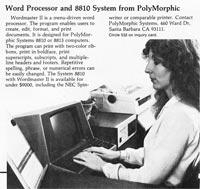 |
WordMaster
A word processing system named WordMaster consisted of a text editor and separate formatter program. Documents could contain formatting commands such as {lpp 55} to set the number of lines per page to 55. The formatting commands were intended primarily for fixed-pitch (not proportionally spaced) printers. For letter-quality printing, a daisy wheel printer or modified IBM Selectric typewriter was often used.
In their 1980 advertisement (left), the list price for a one-disk-drive system with a letter-quality printer was $9,000 - about $24,000 in 2012 dollars.
|
In addition to WordMaster, PolyMorphic Systems also sold programs for Accounts Receivable, Accounts Payable, Inventory Control, Mail List, PLAN (Polymorphic Language for ANalysis), Universal Plotter, and Loan and Investment Analysis.
The printer driver was a small, modular part of the system code. It could be replaced in order to support different printers or printer interfaces.
Files and directories
The disk drives were distinguished by numbers enclosed in angle brackets such as <1>, rather than the drive letter convention (A:) used by CP/M and later MS-DOS. File names were case-sensitive and could contain up to 31 characters plus a two-character extension. For example, a text file might be named Notes.TX. Various file extensions had predefined meanings: .GO for executable files, .BS for BASIC programs, .OV for overlays. Overlays were used extensively to provide more code space for the operating system, but their frequent loading caused a lot of disk activity, slowing the system.
If a file named INITIAL.TX was present when the system booted, commands listed in that file were executed automatically, similar to the AUTOEXEC.BAT file of an MS-DOS system.
Later versions of Exec supported subdirectories. These were named with a .DX extension. The file naming syntax continued to use angle brackets. For example, a file in a second-level subdirectory on drive 2 might be named <2<Projects<Dan<Accounts.TX. Unlike MS-DOS and Unix, no explicit "make directory" command was needed. When a program tried to create a file within a subdirectory, that subdirectory would be automatically created (if it didn't already exist).
The L command would display a disk directory on the screen, and the DIR command would send a directory listing to the printer. For example, DIR 2 would print the directory of the diskette in drive 2. The illustration (right) shows several characteristics of the Poly directory structure. Each file had a Size and Address (in 256-byte sectors). A Load Address (La) and Start Address (Sa) for executable files indicated where the program would load and run in memory. The name of the file was printed last.
|
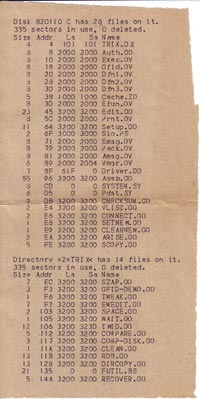 |
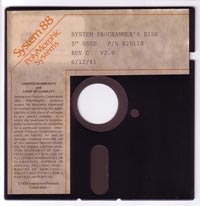 |
In the listing above, there is a subdirectory called TRIX containing useful system utility programs. These were provided as part of the System Programmer's Guide package. A powerful program called SZAP (Super Zap) could edit memory or diskette sectors directly - a bit like Norton Utilities from the DOS world, years later. TWEAK would hide or unhide files by flipping the System bit (as the DOS/Windows "hidden" and "system" attribute bits do today).
RDB was a Relocating Debugger, great for assembly language programming. COMPARE and COMP-DISK would compare files and entire disks, respectively, to validate a copy.
For more on these, see the System Programmer's Guide manual (below). |
The only
big feature missing from this operating system was a more complex disk directory structure. Most filesystems allocate disk sectors as needed, and any unused sectors (belonging to deleted files) are automatically reused. In MS-DOS, the File Allocation Table (FAT) keeps track of which sectors belong to which files.
Poly's file layout was more simple: each file occupied a contiguous set of sectors on disk. This meant that only one file could be "growing" (open for writing) at a time, on a given drive. It also meant that a disk would need to be PACKed occasionally, to reclaim free space from deleted files.
In Poly's defense, this design had one advantage: it allowed files to be reliably undeleted. The ARISE command would bring a deleted file back to life.
88/MS (Mass Storage subsystem)
We always need more storage. Poly's 88/MS answered that need, with two, full-size (8") Shugart SA-800 diskette drives, housed in the same size chassis as the 8813. These were available in single-sided or double-sided variety, both double-density. We referred to them as SSDD and DSDD respectively. Unfortunately, diskettes couldn't be interchanged between the two.
The storage capacity was 630K bytes per diskette, and twice that for double sided. This add-on unit sold for around $4000, nearly the same as the 8813 computer to which it was connected.
You still needed the minifloppy drives, though. An 8813 couldn't boot from the 88/MS diskettes.
The press release to your right gives more details about the 88/MS. This announcement came out in late September 1978, the same week that the U.S. Post Office unveiled its plan to use nine-digit ZIP codes. |

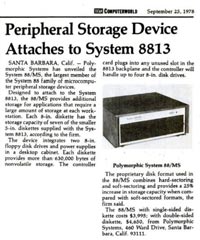
|
System 8810
When diskettes only stored 90K bytes, you needed several of them online at all times to have room for the operating system, programs, and data. But with the double-sided, double-density (DSDD) drives holding 360K bytes each, a one-drive system became feasible. PolyMorphic created a "shrunken" 8813 with only one drive, in a smaller chassis using the five-slot Poly-88 motherboard. This was called the 8810.
Still, a second drive could be very handy for data, or for creating backups. Your webmaster took an 8810 chassis and coverted it to a two-drive system using half-height drives (photo to right).
|
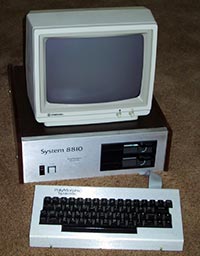 |
HD/18 Hard Drive subsystem
Using a SASI hard drive and controller (the predecessor of SCSI), the HD/18 was a hard drive mass storage unit, housed in an 8810-size chassis. Its storage capacity was 18 MB.
Software called Volume Manager partitioned the available space into several logical disk drives, similar to the FDISK partitioning command used by other operating systems. This was needed since the Poly OS could only access up to 65,535 sectors of 256 bytes each, for a maximum of 16 MB per logical drive.
MS-DOS systems had similar limitations which restricted hard drive volumes to a maximum size of 2 GB until the FAT-32 filesystem was released. |
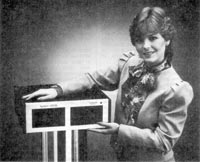 |
Other configurations
TwinSystem - The TwinSystem was marketed as "Get more work done on a computer built for two." The System 8813 TwinSystem had an additional RAM card, video card, keyboard and monitor. Bank switching between the RAM cards allowed the CPU to keep two applications in memory simultaneously. However, the TTL-level keyboard interface limited the distance between the two user stations to a few feet. The PorFavor command allowed one workstation to execute a program in the other's memory space.
CP/M - The dominant operating system for microcomputers in this era was CP/M. Unmodified Poly systems were unable to run CP/M, for several reasons:
- Hard-sectored floppy disks. Nearly all CP/M systems used soft-sectored diskettes, so it was difficult to transport information between CP/M and Poly systems. (The NorthStar Horizon also used hard-sectored diskettes - another feature it had in common with the 8813.)
- Memory map. CP/M required RAM from addresses 0000 to (ideally) FFFF hex. The Poly CPU and VTI cards mapped ROM and video memory into the area between 0000 and 1FFF.
Late in the system's lifetime, hardware modifications were introduced to solve the memory map issues, and a version of CP/M was released for the 8813. But it was too late. By then, the market had moved on to PC-compatible 80x86 machines.
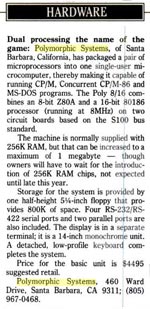 The 16-bit Poly never appeared The 16-bit Poly never appeared
PolyMorphic had big plans to enhance their system with a 16-bit processor and IBM-PC compatibility. This was announced and predicted several time during the early 1980s. In an InfoWorld news release from 1984 (right), Poly described a system with dual processors: a Z80 and an 80186, capable of running CP/M, Concurrent CP/M-86, and MS-DOS. There was no mention of continuing to run Exec or your existing Poly programs.
Alas, such a system was never delivered.
Documentation
All of the System 8813 documentation applied to the 8810 as well. The systems only differed in the number of floppy drives and the size of the chassis. Their software was identical.
System 8813 User's Manual
System 8813 WordMaster Manual
System 8813 BASIC Manual
System 8813 BASIC Reference Guide
System 8813 Macro Assembler
System 8813 Confidence Manual
System Programmer's Guide
Illustrations
|
|